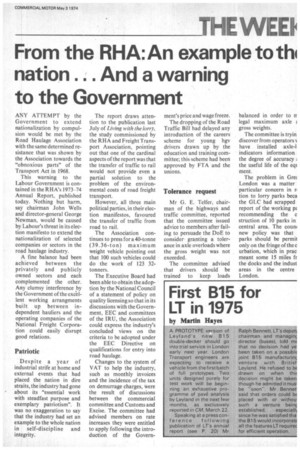From the RHA:An example to thl nation. . . And a warning to the Government
Page 13

If you've noticed an error in this article please click here to report it so we can fix it.
ANY ATTEMPT by the Government to extend nationalization by compulsion would be met by the Road Haulage Association with the same determined resistance that was shown by the Association towards the "obnoxious parts" of the Transport Act in 1968.
This warning to the Labour Government is contained in the RHA's 1973-74 Annual Report, published today. Nothing but harm, say chairman John Wells and director-general George Newman, would be caused by Labour's threat in its election manifesto to extend the nationalization of selected companies or sectors in the road haulage industry.
A fine balance had been achieved between the privately and publicly owned sectors and each complemented the other. Any clumsy interference by the Government of the excellent working arrangments built up between independent hauliers and the operating companies of the National Freight Corporation could easily disrupt good relations.
Patriotic
Despite a year of industrial strife at home and external events that had placed the nation in dire straits, the industry had gone about its "essential work with steadfast purpose and exemplary patriotism". It was no exaggeration to say that the industry had set an example to the whole nation in self-discipline and integrity. The report draws attention to the publication last July of Living with the lorry, the study commissioned by the RHA and Freight Transport Association, pointing out that one of the cardinal aspects of the report was that the transfer of traffic to rail would not provide even a partial solution to the problem of the environmental costs of road freight transport.
However, all three main political parties, in their election manifestos, favoured the transfer of traffic from road to rail.
The Association continues to press for a 40-tonne (39.36-ton) maximum weight vehicle pointing out that 100 such vehicles could do the work of 123 32tonners.
The Executive Board had been able to obtain the adoption by the National Council of a statement of policy on quality licensing so that in its discussions with the Government, EEC and committees of the IRU, the Association could express the industry's concluded views on the criteria to be adopted under the EEC Directive on qualifications for entry into road haulage.
Changes to the system of VAT to help the industry, such as monthly invoices and the incidence of the tax on demurrage charges, were the result of discussions between the commercial committee and Customs and Excise. The committee had advised members on rate increases they were entitled to apply following the introduction of the Govern ment's price and wage freeze.
The dropping of the Road Traffic Bill had delayed any introduction of the careers scheme for young hgv drivers drawn up by the education and training committee; this scheme had been approved by FTA and the unions.
Tolerance request
Mr G. E. Telfer, chairman of the highways and traffic committee, reported that the committee issued advice to members after failing to persuade the DoE to consider granting a tolerance in axle overloads where the gross weight was not exceeded.
The committee advised that drivers should be trained to keep loads balanced in order to n legal maximum axle ; gross weights.
The committee is tryin discover from operators N have installed axle-I indicators information the degree of accuracy ; the useful life of the eqi ment.
The problem in GreE London was a matter particular concern in n tion to lorry parks beca the GLC had scrapped report of the working pE recommending the c struct ion of 10 parks in central area. The counl new policy was that parks should be permit only on the fringe of the c urbation, which in prac meant some 15 miles fr the docks and the indust areas in the centre London.




























































































